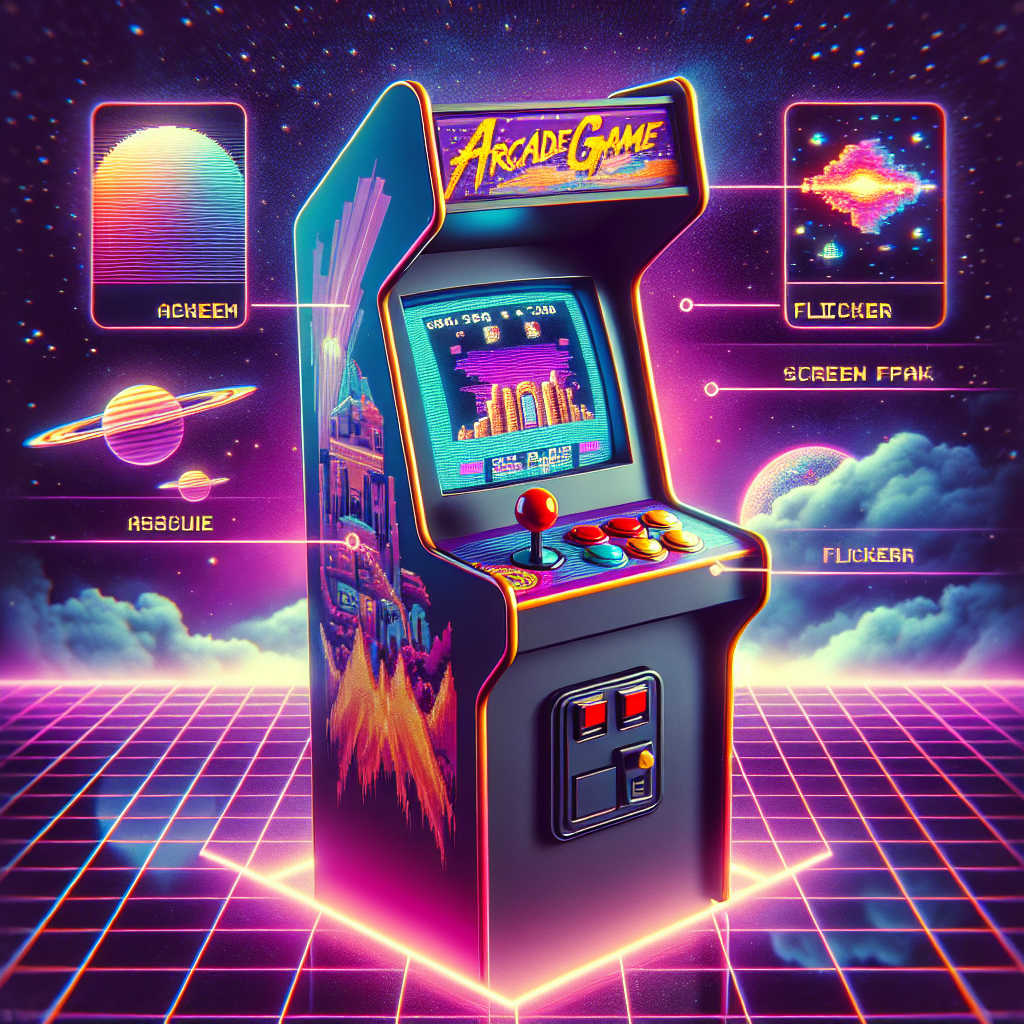How Do You Reduce Screen Flicker In Older Video Games?
Imagine playing your favorite video game from the 90s, relishing the nostalgic graphics and thrilling gameplay. But as you dive deeper into the virtual world, an annoying distraction starts to creep in: screen flicker. Don’t you wish there was a way to reduce this irritating phenomenon without compromising the essence of the game? In this article, we will explore effective techniques to minimize screen flicker in older video games, allowing you to fully immerse yourself in the pixelated wonders of the past.
Understanding the Causes and Solutions of Screen Flicker
Adjust Refresh Rate and Resolution
Changing the Refresh Rate
One effective way to reduce screen flicker in older video games is by adjusting the refresh rate of your monitor. The refresh rate refers to how many times per second the monitor updates the image on the screen. By increasing the refresh rate, you can minimize flickering and create a smoother gaming experience.
To change the refresh rate, you can follow these steps:
- Right-click on your desktop and select “Display Settings” or “Screen Resolution.”
- In the display settings, navigate to the “Advanced Display Settings” or “Display Adapter Properties” option.
- Look for the “Monitor” tab and select it.
- From the drop-down menu, choose a higher refresh rate if available.
- Click on “Apply” and then “OK” to save the changes.
Adjusting the Resolution
Another way to address screen flicker is by adjusting the resolution of the game. Some older games may not be optimized for newer monitor resolutions, causing flickering issues. By modifying the resolution, you can find a setting that works better with your specific monitor.
To adjust the resolution, you can follow these steps:
- Launch the game and navigate to the settings or options menu.
- Look for a section related to graphics or display settings.
- Experiment with different resolution options, choosing one that reduces or eliminates screen flicker.
- Apply the changes and exit the settings menu.
Using Custom Resolution Tools
In addition to the built-in resolution options provided by the game, you can also consider using custom resolution tools. These tools allow you to set a resolution outside of the standard options provided. This can be particularly useful for older games that may not have a wide range of resolution choices.
There are various custom resolution tools available, such as CRU (Custom Resolution Utility) for Windows or SwitchResX for macOS. These tools provide more flexibility in adjusting the resolution to suit your specific needs and can help reduce screen flicker in older video games.
Configure Graphics Settings
Enabling V-Sync
V-Sync, short for Vertical Synchronization, is a feature that synchronizes the game’s frame rate with the refresh rate of your monitor. Enabling V-Sync can help reduce screen tearing and flickering. It ensures that the monitor only displays whole frames, thereby creating a smoother gameplay experience.
To enable V-Sync, you can usually find an option within the game’s graphics settings menu. Look for a checkbox or toggle switch labeled “V-Sync” or “Vertical Sync.” Simply enable this option, apply the changes, and restart the game if necessary.
Disabling Post-Processing Effects
Post-processing effects, such as motion blur or depth of field, can contribute to screen flicker in older video games. Disabling these effects can reduce the strain on your graphics card and minimize flickering.
To disable post-processing effects, navigate to the game’s graphics settings menu and look for options related to image enhancement or post-processing. You may find checkboxes or sliders to control specific effects. Experiment with disabling different effects to determine which ones may be causing the screen flicker.
Adjusting Anti-Aliasing
Anti-aliasing is a technique used in computer graphics to reduce jagged edges and create smoother lines and curves. However, some older games may not handle anti-aliasing well, leading to screen flicker. By adjusting the anti-aliasing settings, you can find a balance between smoothness and reducing flickering.
In the game’s graphics settings, look for options related to anti-aliasing. You may come across settings such as “FXAA,” “MSAA,” or “SSAA.” Experiment with different anti-aliasing modes or try disabling it altogether to see if it reduces flickering in the game.
Toggling Motion Blur
Motion blur is another visual effect commonly used in games to simulate realistic motion. However, excessive motion blur can contribute to screen flicker, especially in older games. Toggling the motion blur settings can help reduce flickering and improve visual clarity.
Check the game’s graphics settings for an option to enable or disable motion blur. It may be labeled as “Motion Blur,” “Motion Blur Amount,” or something similar. Try disabling motion blur and see if it reduces the screen flicker. Some players may prefer to keep a minimal amount of motion blur for a more cinematic experience, so find the setting that works best for you.
Disabling Dynamic Shadows
Dynamic shadows are realistic shadows that change in real-time based on the position of game objects or light sources. While dynamic shadows enhance the visual quality of newer games, they can sometimes cause screen flicker in older titles. Disabling dynamic shadows can alleviate the flickering issue and improve gameplay performance.
Look for a graphics settings option related to shadows, such as “Shadow Quality” or “Shadow Resolution.” Lowering the shadow quality or completely disabling dynamic shadows can reduce the strain on your system, resulting in smoother gameplay without screen flicker.

Update Graphics Drivers
Importance of Graphics Driver Updates
Keeping your graphics drivers up to date is crucial for optimal performance in older video games. New driver updates often incorporate compatibility improvements, bug fixes, and optimizations that can address screen flicker issues. It’s recommended to regularly check for and install the latest graphics driver updates from your graphics card manufacturer’s website.
Updating Graphics Drivers on Windows
To update graphics drivers on Windows, follow these steps:
- Right-click on the “Start” button and select “Device Manager.”
- Expand the “Display Adapters” category.
- Right-click on your graphics card and select “Update driver.”
- Choose the option to search automatically for updated driver software.
- If Windows finds an updated driver, follow the on-screen instructions to install it.
Alternatively, you can visit the manufacturer’s website (such as NVIDIA, AMD, or Intel) and download the latest driver for your specific graphics card model. Manually installing the driver ensures you have the most recent version available.
Updating Graphics Drivers on macOS
To update graphics drivers on macOS, follow these steps:
- Click on the Apple menu and select “System Preferences.”
- Choose “Software Update.”
- If an update for your graphics driver is available, it will be listed in the Updates section.
- Click on the “Update” button next to the graphics driver update.
- Follow the on-screen instructions to install the update.
Alternatively, you can visit the graphics card manufacturer’s website (such as NVIDIA or AMD) to download and install the latest driver directly.
Updating Graphics Drivers on Linux
Updating graphics drivers on Linux varies depending on the distribution you are using. However, most Linux distributions provide a built-in package management system that includes graphics driver updates.
To update graphics drivers on Ubuntu-based distributions, you can follow these steps:
- Open the “Software & Updates” utility from the system settings.
- Navigate to the “Additional Drivers” tab.
- If there are any available updates for your graphics driver, they will be listed here.
- Select the latest driver version and click on “Apply Changes” to install it.
For other Linux distributions, consult the official documentation or support forums specific to your distribution for guidance on updating graphics drivers.
Apply Compatibility Fixes
Running the Game in Compatibility Mode
Compatibility mode is a feature available in modern operating systems that allows you to run software designed for older versions of the OS. By running an older game in compatibility mode, you may be able to overcome screen flicker issues caused by incompatibilities between the game and the newer OS.
To run a game in compatibility mode on Windows, follow these steps:
- Right-click on the game’s executable file or shortcut and select “Properties.”
- In the properties window, navigate to the “Compatibility” tab.
- Check the box that says “Run this program in compatibility mode for.”
- Select the compatible operating system from the drop-down menu.
- Click on “Apply” and then “OK” to save the changes.
Using Compatibility Troubleshooter
If running the game in compatibility mode doesn’t solve the screen flicker problem, you can try using the compatibility troubleshooter. This tool can automatically scan and apply compatibility settings to a game, reducing the chances of compatibility-related issues.
To use the compatibility troubleshooter on Windows, follow these steps:
- Right-click on the game’s executable file or shortcut and select “Troubleshoot compatibility.”
- Windows will launch the compatibility troubleshooter and analyze the game.
- Follow the on-screen prompts to let Windows apply recommended compatibility settings.
- Test the game to see if the screen flicker issue has been resolved.
Applying Community Patches or Mods
In some cases, dedicated communities of gamers and developers create patches or modifications (mods) to address compatibility and performance issues in older video games. These patches or mods can often fix screen flicker problems and provide additional enhancements.
Check online forums, gaming communities, or dedicated websites for the specific game you’re experiencing screen flicker with. Look for community-created patches or mods that target the flickering issue. Follow the installation instructions provided by the community and enjoy the improved gaming experience.

Utilize Emulators or Virtual Machines
Running the Game through an Emulator
Emulators allow you to play older games on modern hardware by recreating the original gaming system’s environment. Running an older game through an emulator can help address screen flicker issues by providing better compatibility with newer hardware and software.
To run an older game through an emulator, you’ll need to:
- Find a reliable emulator that supports the gaming system the game was originally designed for.
- Download and install the emulator software on your computer.
- Obtain a copy of the game ROM file or disk image for the emulator.
- Launch the emulator and open the game ROM file or disk image.
- Configure any necessary settings within the emulator to optimize performance and minimize screen flicker.
Emulators are particularly useful for playing console games from previous generations. They provide a comprehensive solution for compatibility issues and can deliver an enhanced experience without screen flickering.
Using a Virtual Machine to Play
For certain older games that are incompatible with the latest operating systems, you can use a virtual machine (VM) to create a separate environment where the game can run. A VM enables you to install and run an older operating system that may be more compatible with the game.
To play a game using a virtual machine, follow these steps:
- Install a virtualization software such as VirtualBox or VMware on your computer.
- Obtain a copy of the older operating system that is compatible with the game.
- Create a new virtual machine within the virtualization software.
- Install the older operating system on the virtual machine.
- Install the game on the virtual machine’s operating system.
- Launch the virtual machine and start the game within the virtual environment.
Running the game in a virtual machine can provide a dedicated platform that replicates the original gaming environment, minimizing compatibility issues and potential screen flickering.
Investigate In-Game Settings
Checking Game-specific Graphics Options
Each game may have its own set of graphics settings that can affect screen flicker. These in-game options allow you to fine-tune various visual elements and optimize performance.
Explore the game’s settings menu, specifically the graphics or display section, to identify options that may contribute to screen flickering. Look for settings related to resolution, refresh rate, graphics quality, and effects. Make adjustments to these settings and test the game to see if the flickering improves or disappears.
Adjusting FOV (Field of View) Settings
The Field of View (FOV) setting determines how much of the game world is visible on the screen at any given time. A narrow FOV can sometimes lead to screen flickering, especially if the game has fast movements or quick camera rotations.
Check if the game allows you to adjust the FOV setting in its graphics or gameplay options. Experiment with widening the FOV to see if it reduces screen flicker. A broader FOV can help reduce strain on the eyes and create a more comfortable gaming experience.

Use External Tools or Utilities
Third-Party Graphics Tweaking Tools
Third-party graphics tweaking tools offer additional customization options beyond what the game provides. These tools can help fine-tune graphics settings and optimize performance, potentially reducing screen flickering.
Some popular third-party graphics tweaking tools include NVIDIA Inspector, AMD Radeon Software, and MSI Afterburner. These tools often offer advanced settings for graphics cards, allowing you to modify parameters such as GPU clock speed, fan control, and more.
Before using any third-party graphics tweaking tool, make sure to read the documentation and user guides provided by the software developer. Adjust the settings cautiously and test the changes to ensure they improve the screen flickering issue without negatively impacting the game or hardware.
Frame Limiters or Cap Tools
Screen flickering can sometimes occur due to a game’s instability with high frame rates. By limiting the frame rate, you can potentially reduce screen flicker and provide a more stable gaming experience.
There are various frame limiters or frame capping tools available, such as Rivatuner Statistics Server or NVIDIA Control Panel (for NVIDIA graphics cards). These tools allow you to set a maximum frame rate for a specific game, thereby preventing excessive frame rendering that may cause flickering.
Configure the frame limiter or cap tool to your desired frame rate, such as 60 FPS or 30 FPS, and test the game to see if the screen flicker diminishes.
Applying Shader Enhancements
Shader enhancements can improve the visual quality of older games by adding effects such as ambient occlusion, depth of field, or color correction. Certain shader enhancements can also help reduce screen flicker by optimizing the rendering process.
Tools like Reshade or SweetFX provide shader-based graphical improvements and can be used to reduce screen flicker in older video games. These tools can be installed and configured to apply specific shader enhancements that may alleviate the flickering issue.
When using shader enhancements, be mindful of the impact on performance and compatibility with the game. Experiment with different settings and shaders to find the optimal setup for reducing screen flicker without compromising the game’s stability or visual quality.
Consider Hardware Modifications
Upgrading Graphics Card
Sometimes, screen flickering in older video games can be attributed to outdated or underperforming graphics cards. Upgrading your graphics card to a more powerful and compatible model can often resolve screen flickering issues.
Before investing in a new graphics card, research the system requirements for the game you’re experiencing flicker in. Identify the recommended graphics card specifications and ensure the new card meets or exceeds those requirements. Consult with hardware experts or gaming communities for recommendations on suitable graphics cards.
Upgrading your graphics card not only improves performance but also allows for better compatibility with modern games and reduces the likelihood of screen flickering.
Overclocking or Underclocking
Overclocking or underclocking your graphics card can be an advanced option to potentially reduce screen flickering. Overclocking refers to increasing the clock speed of the graphics card, while underclocking means reducing it.
However, it’s important to exercise caution when overclocking or underclocking, as improper settings can lead to system instability or damage to the hardware. It’s recommended to thoroughly research the process, follow reputable guides, and use reliable overclocking software specific to your graphics card.
If conducted safely and appropriately, overclocking or underclocking can optimize the graphics card’s performance and potentially resolve screen flickering issues in older video games.
Modifying Monitor Hardware
For some cases of screen flickering, modifying your monitor’s hardware can provide a solution. This approach is more advanced and should be done cautiously, as it involves physically altering the display.
If your monitor supports adjustable refresh rates, experiment with different refresh rate settings to see if it reduces or eliminates screen flicker. Consult the monitor’s user manual or the manufacturer’s website for instructions on adjusting the refresh rate.
Additionally, some monitors may have options to adjust the panel overdrive or response time settings. Lowering these settings can potentially reduce screen flicker, but keep in mind that it may introduce other visual artifacts or affect the overall image quality.
When considering any modifications to monitor hardware, it’s essential to understand the potential risks, warranty implications, and the specific capabilities of your monitor.

Seek Technical Support and Communities
Online Forums or Social Media Groups
If you’ve exhausted all other options and are still experiencing screen flickering in older video games, don’t hesitate to seek help from online forums or social media groups. Many gaming communities have dedicated threads or groups where fellow gamers can share their experiences and provide potential solutions.
Describe your specific issue in detail and provide information about your gaming setup, including the game, operating system, graphics card, and monitor. The community members can offer suggestions, troubleshoot alongside you, and share any tips or fixes they have discovered.
Remember to approach online forums and social media groups with kindness and respect, as the members are volunteering their time and expertise to assist fellow gamers.
Contacting Game Developers or Publishers
If all else fails, consider reaching out to the game developers or publishers directly for technical support. They may have specific knowledge about the game’s compatibility issues or advanced troubleshooting steps that can address the screen flickering problem.
Visit the official website of the game or the developer to find contact information or support channels. Some companies offer dedicated customer support services via email, live chat, or ticketing systems. Provide detailed information about the issue and any steps you have already taken to resolve it. The development team may be able to provide a solution or offer guidance based on their expertise.
Preserve and Emulate Game Files
Backing up Game Files
In some cases, the screen flickering in older video games may be caused by corrupted game files or missing assets. Creating a backup of the game files ensures that if any issues occur, you can restore the game to its original state.
To back up game files, locate the game’s installation directory on your computer. Copy the entire folder and save it to an external storage device or a separate location on your hard drive. This backup allows you to restore the game files if necessary or transfer them to another device.
Periodically creating backups can also protect your progress and settings in case of system failures or hardware upgrades.
Using Fan-Made Patches or Enhancements
Fan-made patches or enhancements can improve the compatibility and stability of older video games, including addressing screen flickering issues. These patches are often developed by dedicated community members who are passionate about preserving and enhancing classic games.
Research online gaming communities or dedicate websites for the specific game you’re experiencing flickering in. Look for fan-made patches or enhancements that have been designed to address compatibility issues or bugs.
Before applying any patches or enhancements, ensure they come from trustworthy sources and follow any instructions provided. Additionally, consider any potential risks or implications, such as affecting online multiplayer modes or violating the game’s terms of service.
Fan-made patches or enhancements can be a valuable resource for resolving screen flickering issues and providing an enhanced gaming experience for older video games.





